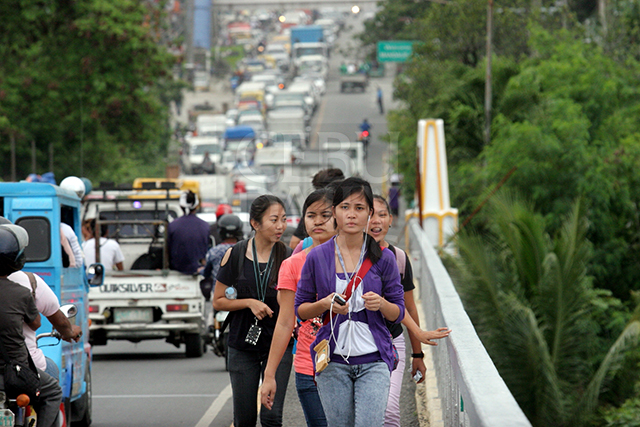
Pedestrians, including workers and students, choose to walk across the old Mandaue-Mactan Bridge than ride a PUJ because of the traffic congestion caused by the bridge repairs. (CDN PHOTO/JUNJIE MENDOZA)
Faced with a traffic crisis that has a widespread effect both on the economy of Cebu and the sanity of the commuters, various sectors have found varying ways to adapt and find solutions to a situation that is expected to extend for at least six months.
For one, the city governments of Mandaue and Lapu-Lapu have reached an agreement on a scheme to alternately use the Mandaue-Mactan Bridge on 12-hour shifts once it will be limited to only one-way use after Feb. 15.
Aside from avoiding traffic gridlock zones by taking the ferry service to cross the Mactan Channel, many commuters who regularly travel between mainland Cebu to Mactan Island have heeded the advice to leave early in order to reach their destinations on time.
Yesterday, traffic-enforcing agencies in both Mandaue and Lapu-Lapu cities reported that except during rush hours, traffic was light to moderate.
Lapu-Lapu City Traffic Management System (CTMS) head Frank Brazil said yesterday’s traffic flow during off-peak hours in the city was “normal” and “like an ordinary day.”
However, at around 3 p.m. yesterday, a number of commuters were observed crossing the Mandaue-Mactan Bridge on foot and vehicles were still bumper-to-bumper, though it was still off rush hour.
Glenn Antigua, operations chief of the Traffic Enforcement Agency of Mandaue (TEAM), said that one of the reasons traffic was light in the city yesterday was because many motorists left their homes earlier than usual.
Flordeluna Aying, 28, a resident of Barangay Bankal, Lapu-Lapu City, said she left her home as early as 5:30 a.m. yesterday because she did not want to experience the traffic travails she went through last Tuesday, when her usually one-hour travel time to her workplace stretched to three hours.
“Last (Tuesday) I left home at 6:30 a.m. but at 7:45 a.m. I was still at the corner going to the (Mactan Cebu International) airport,” she recalled.
It was then that Aying decided to cross the Mandaue-Mactan Bridge (old bridge) on foot and reached Mandaue City at 8:30 a.m. From there, she took a public utility jeepney bound for Cebu City and arrived at her workplace, a hotel at the Ayala Center area, at around 9:30 a.m.
Aying believed there was less traffic yesterday because the old bridge was reopened to two-way traffic.
The Department of Public Works and Highways (DPWH) closed one lane of the bridge last Monday for the bridge’s rehabilitation work. But the following day, the agency decided to reopen it to two-way traffic until Feb. 15 due to heavy congestion along the bridge area and also to allow the Metro Cebu Water District (MCWD) time to secure its pipes attached to the bridge from possible damage once the bridge’s rehabilitation works begin.
Antigua said the DPWH’s decision to defer closing one lane of the old bridge was a major factor in easing traffic.
He said the deployment of policemen from the city’s Traffic Management Unit (TMU) in traffic chokepoints also helped ensure steady, albeit slow, vehicular flow. Aside from 30 traffic personnel from TEAMS, TMU personnel were deployed in the intersections along UN Avenue and A.C. Cortes Avenue, he said.
ROUTING SCHEMES
TEAM executive director Florentino Nimor Jr., said his office, the DPWH and his counterpart in Lapu-Lapu City have mapped out a routing scheme that would address traffic congestion once the old bridge would again be limited to one-way traffic after Feb. 15.
Among the schemes to be adopted by both Mandaue and Lapu-Lapu cities would be for vehicles from Lapu-Lapu to use the bridge from 1 a.m. to 12 noon and for vehicles from Mandaue to use the bridge from 1 p.m. to midnight.
“We suggested this because we saw that in the morning, during rush hour, most commuters were heading for Mandaue and at night, it’s the the other way around,” he said.
Nimor said there could be confusion among commuters at first, but he believes the scheme would succeed if there would be coordination between the cities of Mandaue and Lapu-Lapu.
FERRY
The decision of Metro Ferry to provide additional trips to ferry passengers between Cebu City and Mactan Island was also a major factor in easing traffic in Mandaue and Lapu-Lapu cities, said Brazil.
Yesterday, Metro Ferry vessels plying the Muelle Osmeña (Mactan)-Pier 3 (Cebu City) route allowed each ferry to cross Mactan Channel once the vessel has filled up its seating capacity instead of waiting for the usual 30-minute interval.
Arthur Aranda, a captain of one of the Metro ferries, said they usually have about 2,000 passengers each day, but yesterday, the number doubled.
The Maritime Industry Authority-Central Visayas (Marina-7) has called other shipping companies to operate vessels on the Mactan Channel route, but so far, there has been no application, said Marina-7 spokesperson Jose Cabatingan.
Beach resorts on Mactan Island have yet to decide on the recommendation that they open their private wharves as docking areas for passenger ferries crossing Mactan Channel, said DPWH Central Visayas director Ador Canlas.
Canlas said the privately-owned Kasamahan Wharf near General Milling Corp. in Barangay Poblacion, Lapu-Lapu City was also being eyed as a potential docking area for additional sea vessels, along with the Ouano Wharf in Mandaue City.